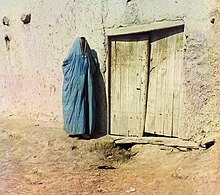Sart
It may be derived from the Sanskrit sārthavāha (सार्थवाह), meaning "merchant, trader, caravan leader", a term supposedly used by nomads to describe town-dwellers, according to Vasily Bartold, Gerard Clauson, and most recently Richard Foltz.
[1][2] The earliest known use of the term is in the 1070 Karakhanid Turkic text Kutadgu Bilig "Blessed Knowledge", in which it refers to the settled population of Kashgar.
[citation needed] Throughout the Qing dynasty, the sedentary inhabitants of the oases around the Tarim speaking Karluk Turkic languages were still largely known as Taranchis or Sarts under the Mongol rulers of Khojan or Chagatai lineages.
In 1911, the Nationalist Chinese under the leadership of Sun Yat-sen overthrew Qing Dynasty rule and established the Republic of China.
Turpan poet Abdulxaliq, having spent his early years in Semey and the Jadidist intellectual centres in Uzbekistan, returned to Xinjiang with a pen name that he later styled as a surname: Uyghur.
In the literature of Imperial Russia in the 19th century the term was sometimes used to denote the Turkic-speaking peoples of Ferghana, Tashkent, Shymkent and the southern Syr-Darya Oblast, also found in smaller numbers in Samarkand and the Emirate of Bukhara.
This confusion reached its peak in the 1897 Russian Empire Census: the Fergana Oblast was held to have a very large Sart population, the neighbouring Samarkand Province very few but a great many Uzbeks.
Historically speaking the Sarts belonged to older settled groups, whereas the Uzbeks were descended from tribes which arrived in the region with Muhammad Shaybani in the 16th century.
In Fergana, the Sarts spoke a Karluk variety that was very close to modern Uyghur and is believed to be the earlier, historical form of Uzbek.
In 1924 the Soviet regime decreed that henceforth all settled Turkic-speaking peoples in Central Asia (and many others who spoke Persian such as in Samarkand and Bukhara)[citation needed] would be known as "Uzbeks" and that the term "Sart" was to be abolished as an insulting legacy of colonial rule.
Historically the various Turkic and Persian peoples of Central Asia were identified mostly by their lifestyle, rather than by any notional ethnic or even linguistic difference.

